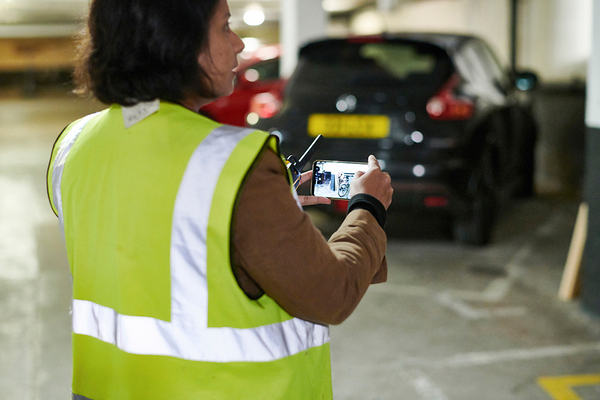You are viewing 1 of your 1 free articles
Dangerous buildings protected by ‘waking watches’ have seen 300 fires since Grenfell, new figures reveal
More than 420 buildings across England are currently protected by a 24-hour ‘waking watch’ due to serious fire safety issues, with more than 300 fires occurring in them since Grenfell.
New figures, gathered by Inside Housing using the Freedom of Information Act (FOIA), underscore the scale of the country’s building safety crisis and how close we have come to a repeat of the disaster.
It comes as the National Fire Chiefs Council (NFCC) issues guidance reminding building owners that the provision of waking watches is “paramount” during the coronavirus crisis – due to the increased fire risk from so many people spending more time at home.
The data comes from responses from 40 of the UK’s 50 fire authorities detailing the number of live waking watches in their area and the number of fires they have responded to at these buildings since Grenfell in June 2017.
London has 289 of the buildings (68%) with waking watches and the London Fire Brigade has responded to 263 fires in these premises since Grenfell.
Click on any column header to sort
| Fire authority | Waking watches | Length of time (if provided) | Fires |
|---|---|---|---|
| London | 289 | 263 | |
| Greater Manchester* | 57 | ||
| Mersey | 9 | They range from June 2018 to February this year | 1 |
| West Midlands | 8 | November 2019 to January 2020 | 4 |
| Cheshire | 7 | October 2019 (all) | 4 |
| Hampshire | 7 | Most have been in place since October and November 2019 | 2 |
| Essex | 6 | 3 | |
| Cleveland | 6 | Since August 2019 and December 2018 | 0 |
| Lancashire | 5 | 7 | |
| Tyne and Wear | 4 | Two have been in place since June 2017, one since December 2017 and one since November 2019 | |
| Northumberland | 3 | Two have been in place since April 2018 and one since December 2019 | 2 |
| Buckinghamshire | 3 | Two have been in place since October 2019 and one since August 2019 | 5 |
| Surrey | 3 | 1 | |
| Warwick | 3 | Since May 2019 | 0 |
| Northants | 2 | Since August 2019 | 4 |
| Kent | 2 | Since December 2019 | 1 |
| Leicestershire | 1 | Since 2017 | 0 |
| Suffolk | 1 | Since February 2020 | 0 |
| West Sussex | 1 | Since January 2020 (overnight only) | |
| Dorset and Wiltshire | 1 | Since December 2017 | 2 |
| Nottinghamshire | 1 | 0 | |
| Hertfordshire | 1 | Since June 2019 | 1 |
| Total | 420 | 300 |
Notes: The following fire authorities said they currently have no waking watches: Shropshire, Staffordshire, Guernsey, Norfolk, Bedfordshire, Lincolnshire, Oxfordshire, Isle of Scilly, Cornwall, Durham and Darlington, Avon, Humberside, North Yorkshire, Cambridgeshire, Derbyshire, and Devon and Somerset. Fire authorities for East Sussex and Scotland said they do not record a figure. Greater Manchester Fire and Rescue service did not respond to the FOIA request, but the figure was taken from a report of the Greater Manchester Combined Authority taskforce on fire safety. It is the total number of buildings with ‘interim fire safety measures’ – the majority of which are understood to involve waking watches.
Source: Responses to Inside Housing FOIA requests, February and March 2020
A waking watch is put in place when a residential building switches to a ‘simultaneous evacuation’ policy due to serious fire safety issues – typically combustible cladding on its walls.
They are supposed to be a temporary measure, but Inside Housing’s data shows they have been in place for years in many places, with some stretching right back to June 2017.
There are concerns the current crisis could extend their use, with work to remove cladding and install fire alarms delayed.
Separate FOIA responses from local authorities reveal the huge cost to the public purse of providing these services, with 34 councils spending a combined £29.4m for watches at 134 buildings over varying timescales.
The largest bill was £10.2m paid by Camden Council in London for waking watch cover at nine towers running from June 2017 to December last year.
Click on any column header to sort
| Local authority | Number of blocks | Cost (total) (£) | Cost (per block) (£) | Length of time | Contractor | Number of fires |
|---|---|---|---|---|---|---|
| South Tyneside | 12 | 19,323 | 1,610 | Tyne Tees Security | 0 | |
| Kensington & Chelsea | 11 | 4,932,623 | 448,420 | Until Aug 2019, three still in place | Event Fire Solutions, Oracle, Vigilant Security | 4 |
| Camden | 9 | 10,205,119 | 1,133,902 | Jun 2017 to Dec 2019 | 5 | |
| Salford | 9 | n/a - provided by Pendleton Together | Still in place | 1 | ||
| Southampton | 8 | 280,000 | 35,000 | For five weeks in early 2018 | CLC Group plus some in house | 0 |
| Barnet | 6 | 487,100 | 81,183 | Three still in place | STM Group UK/Keepmoat (part of cladding works) | 0 |
| Lambeth | 6 | 109,191 | 18,199 | For only a few weeks each | 0 | |
| Westminster | 6 | 946,200 | 157,700 | No longer in place | Event Fire Solutions | 0 |
| Hillingdon | 5 | 324,248 | 64,850 | Six months each | Kingdom Services Group, Scaffolding Access | 0 |
| Rugby | 5 | 1,383,073 | 276,615 | Two ended in Dec 2019 after decant | Stonewall | 0 |
| Southwark | 5 | 2,966,021 | 593,204 | Kier Facilities Services | 2 | |
| Bournemouth | 4 | 15,268 | 3,817 | Insight Security | 0 | |
| Croydon | 4 | 850,657 | 212,664 | 0 | ||
| Gateshead | 4 | 42,312 | 10,578 | Ended in Sep 2019 | Orbis | 0 |
| Manchester | 4 | Private finance initiative | Jul 2017 to Dec 2018 | 0 | ||
| Sandwell | 4 | 49,646 | 12,412 | For five weeks in 2017 | Mitie Security | 0 |
| Sutton | 4 | 259,790 | 64,948 | Still in place | No contractors but temporary staff | 2 |
| Hounslow | 3 | 35,520 | 11,840 | A few weeks each | Enigma Security Solutions | 0 |
| Enfield | 2 | 374,250 | 187,125 | Both now ended | Event Fire Solutions | 0 |
| Greenwich | 2 | 24,192 | 12,096 | 13 months up to Aug 2018 | Global Guardians Management | 0 |
| Islington | 2 | 885,475 | 442,737 | Ended in Jun 2019 | Some in house, the rest CIS Security | 2 |
| Poole | 2 | Contractor bore costs | ||||
| Portsmouth | 2 | 663,412 | 331,706 | Until Aug 19 | MG Security/Mountjoy | 0 |
| Slough | 2 | 1,347,703 | 673,851 | In place Jun 2017 until Dec 2019 | Manpower | 0 |
| Stoke-on-Trent | 2 | 92,272 | 46,136 | CBI Security Services | 0 | |
| Wandsworth | 2 | 1,362,042 | 681,021 | Since Jun 2017. One ended Nov 2019 | Parkguard, plus in house | 0 |
| City of London | 1 | 319,848 | 319,848 | No longer in place | Noonan Services Group | 0 |
| Folkestone & Hythe | 1 | 3,795 | 3,795 | 10 days in Nov 2019 | Prevention and Detection Services | 0 |
| Hackney | 1 | 640,000 | 640,000 | Apr 2019 to Jan 2020 | Triton UK | 0 |
| Kirklees | 1 | 48,000 | 48,000 | Since Dec 2019 | Kings Contractors | 0 |
| Leicester | 1 | 60,048 | 60,048 | Still in place - three-storey homeless hostel | In house | 1 |
| Mansfield | 1 | 224,640 | 224,640 | Urban Security Guards | 0 | |
| North Tyneside | 1 | Not known | Not consistently | In house | 0 | |
| St Albans | 1 | 236,610 | 236,610 | End of Jan 2020 | Black and White Key Security | 0 |
| Welwyn Hatfield | 1 | 189,728 | 189,728 | Still in place | 0 |
Source: Responses to Inside Housing FOIA requests, January and February 2020
Lord Gary Porter, building safety spokesperson at the Local Government Association, said: “Waking watch services are not a long-term solution to protect residents in dangerous buildings, but a short-term solution until dangerous cladding can be removed.
“The current coronavirus pandemic poses a serious challenge to remediation works but the government has been clear that it wants this work to go ahead and we support that, subject to appropriate health and safety advice.”
In the private sector these costs are met by leaseholders, with some paying up to £840 a month each to keep the services in place – on top of bills to remove the cladding and soaring insurance premiums.
The services must be kept in place to avoid the fire services evacuating the buildings, rendering the residents homeless.
In a statement, various cladding action groups across the UK said the coronavirus outbreak had made these costs particularly difficult to meet.
“The huge additional and ongoing costs that many leaseholders have to pay as a result of living in dangerous cladding blocks means they face an impossible decision about work and self-isolation. No income means no ability to pay for the waking watch required for them to stay in that building,” a spokesperson said.



